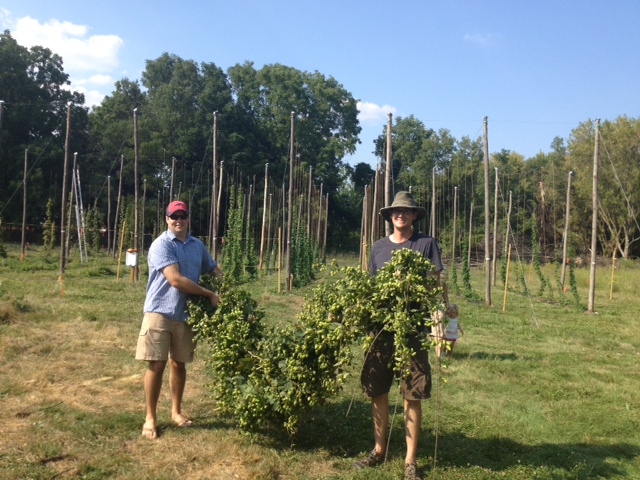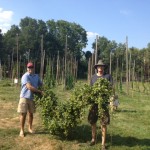McCollum Orchards hosted an old-fashioned harvest party this week to enlist the helping hands of their Niagara County neighbors, willing homebrewers in search of “U-Pick” hops, and any folks interested in experiencing the farm’s first commercial hop harvest. As guests helped owners Rich and Bree Woodbridge cut down Cascade bines and pluck hop cones, then sort them and lay them out on drying racks –– all in 90-degree heat –– the community got a taste of the life of a hop farmer. They also got a taste of banana bread, homemade brownies, pie, hot dogs, and a fresh batch of Wet Frank, a version of Community Beer Works’s Frank Pale Ale wet-hopped with McCollum Centennials, and the homebrewing process itself thanks to a step-by-step demonstration by local homebrewer Weston Cross.
Writing about beer is almost as easy as drinking it, so it’s nice to get into the trenches once in awhile and remember the hard work that’s behind every pint. Among the things I learned:
- Hops are gorgeous. Like, drop-dead gorgeous (hop-head gorgeous?). Open one up for the full effect.
- Hops are fun. No one, young or old, could resist chewing them, dropping them into beer and various other beverages, or spending a few minutes sorting just for the fun of picking out the unusually big or small ones.
- Bines are scratchy! There’s a reason everyone’s wearing gloves. Seeing the red scratches on my knees and arms the day after picking gave me even more respect for what the Woodbridges go through every day.
- Quality control is important. Just as winemakers have to instruct their one-day helpers on proper sorting and selection of grapes (I know I was yelled at by Niagara Editor Bryan Calandrelli more than once for accidentally dropping green or rotten fruit into my tote, back in the day) hop farmers have to worry about their harvest helpers including leaves and stems to be picked out later, or leaving parts of the cone by breaking it apart as they pull. From the base!
- A little ingenuity goes a long way. Thanks to Rich and Bree’s know-how, creativity, and extensive research, their farm design and much of their equipment––from their hopsyard layout to their drying racks––are almost completely DIY and extremely impressive. Check out their blog to read about their ongoing farm developments!
- Sock Hop: because you put hops in a sock when you add them to the wort. Can’t believe I never made the connection.
- Fresh, wet-hopped local beer with local hops? Nothing better. I’ve always preached that beer is (or should be) a local ingredient, and one sip of Wet Frank reaffirmed my beliefs.
I couldn’t be happier that my region now has a local hop source––especially one that’s so much fun to visit!


